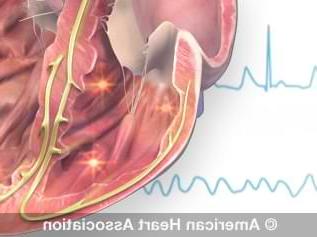其他心律失常
心律失常s include many conditions such as 心动过缓 和 心动过速. Additional heart rhythm disorders are:
阿斯病
阿斯病, also called Stokes-Adams disease, refers to a 心传导阻滞 or other 心律失常 that can slow the heart rate considerably, causing fainting (syncope) or convulsions. It’s caused when the heart’s electrical signals are interrupted as they pass from the upper (atria) to the lower (ventricles) chambers.
心房扑动
心房扑动 occurs when rapidly firing electrical signals cause the muscles in the heart’s upper chambers (atria) to contract at a very rapid rate (250 to 350 times per minute). This leads to an overly fast heartbeat, which can have either a regular or irregular rhythm.
心房扑动 is much less common than 心房纤颤 (AFib or AF), but its causes 和 consequences are similar. Patients with 心房扑动 can also have periods of 心房纤颤.
心房扑动症状
心房扑动 may present with a heartbeat that’s overly fast, irregular or with heart palpitations (feeling a hard, fast or irregular heartbeat in the chest). 其他症状包括:
If you experience these symptoms 和 think you may have 心房扑动, contact your health care professional immediately.
Comorbidities 和 Risk Factors
心房扑动 is often associated with other conditions such as:
- 心脏衰竭
- 以前的 心脏病
- 心脏搭桥手术
- 心脏瓣膜手术
- 阀异常 or 先天性缺陷
- 高血压
- 心房纤颤
- 甲状腺机能障碍
- Alcoholism (especially binge drinking)
- 慢性肺病
- 糖尿病
- 吸烟
- 之前的行程
了解更多关于 心房扑动.
病窦综合征
When the sinus node (also called the sinoatrial or SA node) doesn’t produce its electrical signals properly, 心率减慢, 暂停或加速. This is referred to as sick sinus syndrome.
In this condition, the heart rate can fluctuate between an overly slow rate (心动过缓)和过快的速度(心动过速).
窦性心律不齐
常见于儿童, this type of irregular heart rhythm refers to changes in the heart rate during breathing. The heart rate speeds up for a few beats during inhalation 和 slows down during exhalation. 窦性心律失常是正常的.
Wolff-Parkinson-White Syndrome (WPW)
在这种紊乱中, the electrical pathways between the heart’s upper (atria) 和 lower (ventricles) chambers malfunction. This allows electrical signals to reach the ventricles too early. Those electrical impulses can then be “bounced back” to the atria.
This can produce overly fast heart rates. Other people with WPW Syndrome may not experience any overt symptoms, but still face serious risk.
Some people with WPW also have 心房纤颤.
诊断与治疗
Your health care professional can detect WPW Syndrome through an 心电图 (EKG或ECG). This noninvasive test can reveal irregularities in your heart rhythm.
Your treatment plan will depend on several factors, including your risk of future 心律失常s as well as the frequency 和 severity of your symptoms. People who don’t experience symptoms may not require treatment.
Possible treatment options for WPW Syndrome may include:
消融 is the most common treatment for WPW Syndrome. It has a high success rate 和 a low risk of complications.






